
SaaS User Behavior: Tracking Methods and Analysis Tips

by
François Lecomte
Sep 25, 2024
Identify and convert your most valuable users
Sign Up
Understanding your users is crucial for success. Let's dive into the world of user behavior tracking and explore how it can drive growth for your business.
What is User Behavior Tracking?
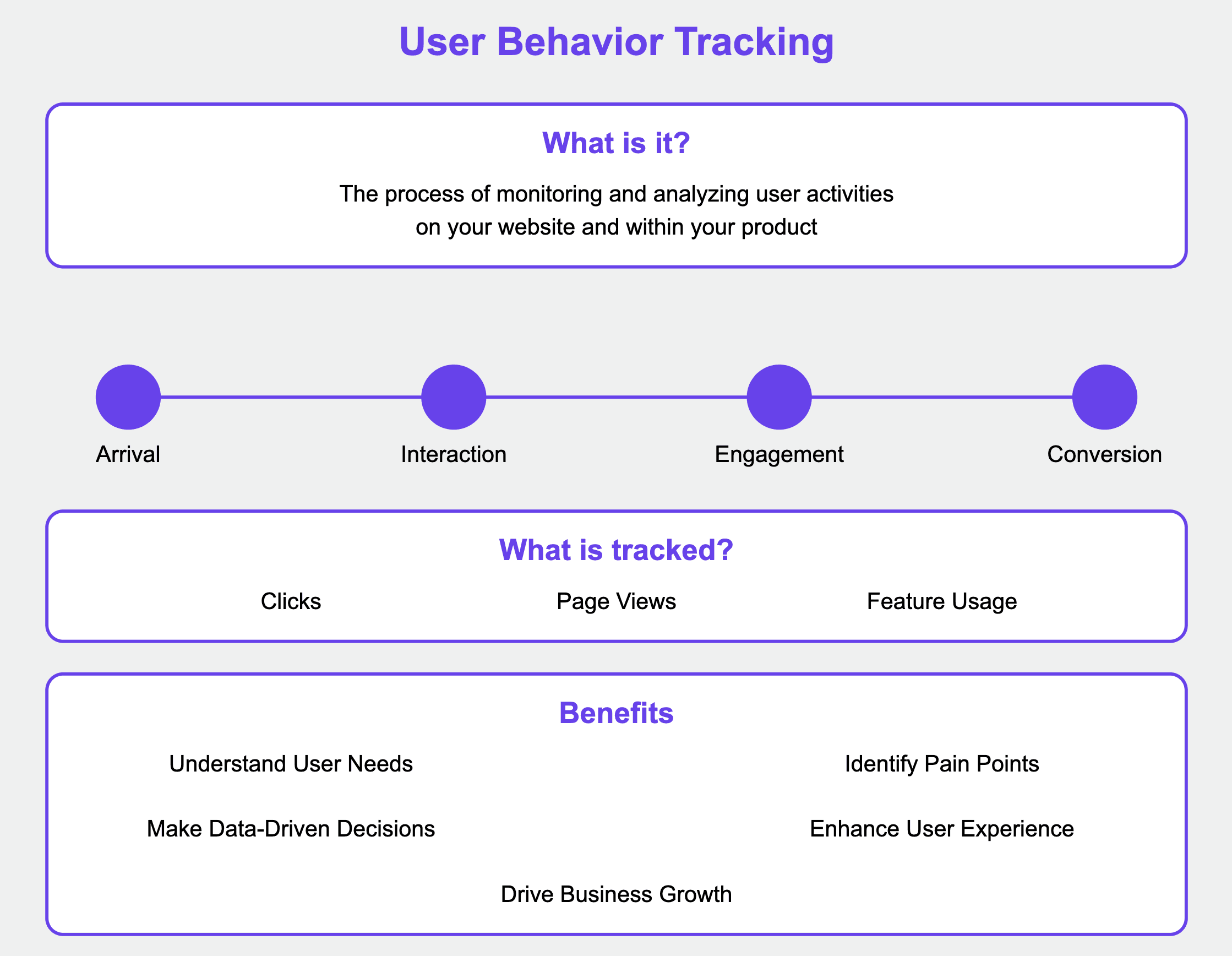
User behavior tracking is the process of monitoring and analyzing the activities of users on your website and within your product. It involves recording actions such as clicks, page views, feature usage, and much more.
Essentially, it's about understanding the journey of your users from the moment they arrive on your site until they become paying customers (and beyond).
But it's more than just collecting data. It's about gaining insights into how users interact with your product, what they find valuable, and where they might be struggling. This information is gold for SaaS companies looking to improve their product and grow their user base.
User behavior tracking allows you to see your product through your users' eyes. It helps you understand their needs, preferences, and pain points, enabling you to make data-driven decisions that enhance user experience and drive business growth.
Why is User Behavior Tracking Important?
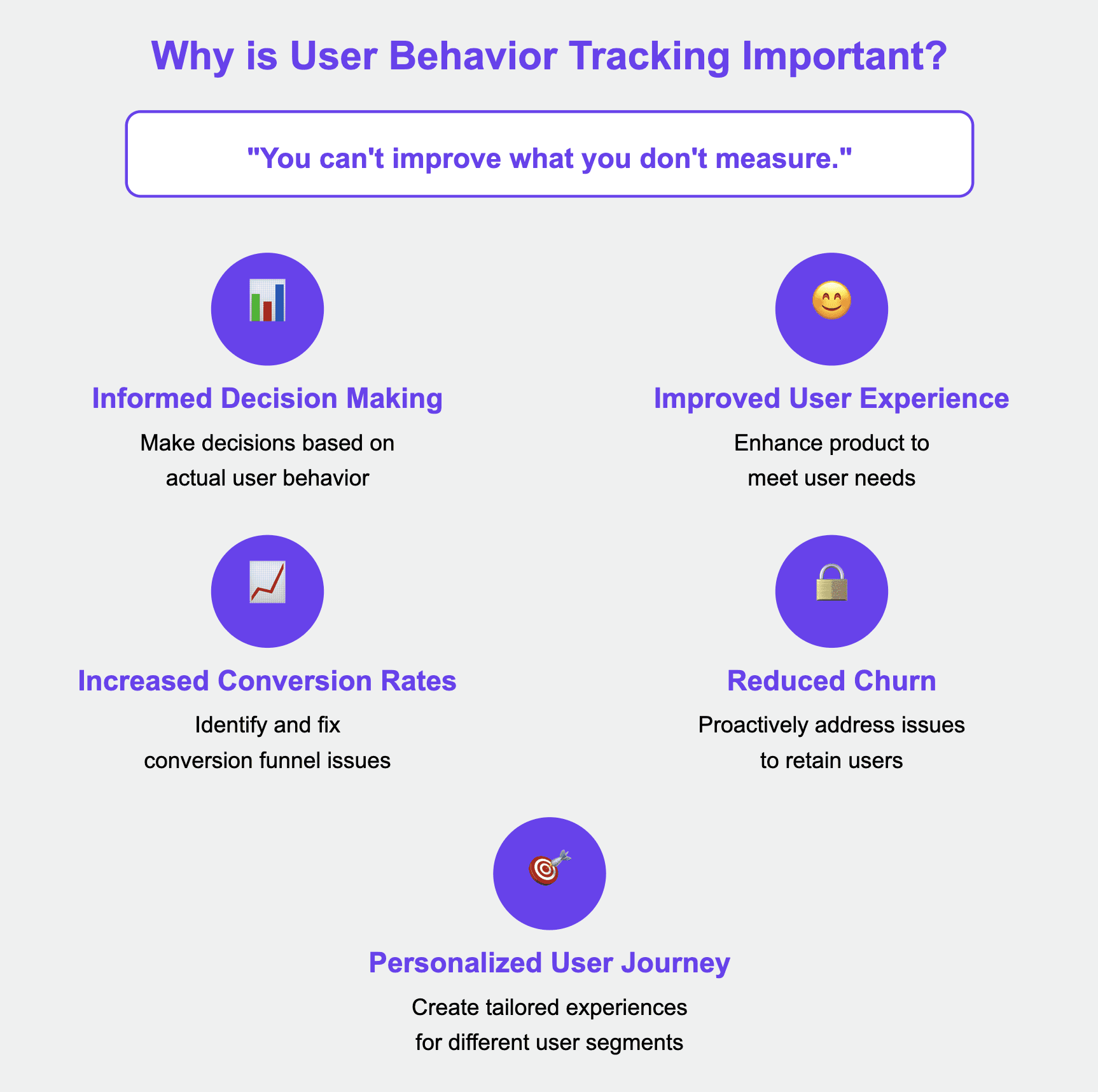
You've probably heard the saying, "You can't improve what you don't measure." This couldn't be truer for SaaS businesses. Without tracking, you're essentially operating in the dark, making decisions based on guesswork rather than data. Let's explore some key benefits:
Informed Decision Making: Tracking provides insights that guide product improvements and marketing strategies. Instead of relying on hunches, you can make decisions based on actual user behavior.
Improved User Experience: By understanding user pain points, you can enhance your product to better meet user needs. This leads to higher user satisfaction and retention rates.
Increased Conversion Rates: Identify what works (and what doesn't) in your conversion funnel. You can pinpoint where users are dropping off and make necessary adjustments to improve conversion rates.
Reduced Churn: Spot potential churners early and take action to retain them. By identifying patterns that lead to churn, you can proactively address issues before users decide to leave.
Personalized User Journey: Use behavioral data to create tailored experiences for different user segments. This personalization can significantly enhance user engagement and satisfaction.
Efficient Resource Allocation: Focus your efforts on features and marketing channels that deliver the best results. This ensures you're investing your resources where they'll have the most impact.
Competitive Advantage: In a crowded SaaS market, understanding your users better than your competitors can give you a significant edge.
The Three Pillars of User Behavior Tracking
Now, let's get into the meat of user behavior tracking. There are three main areas we need to focus on:
Acquisition: This is all about understanding how users find and access your product.
Activation: Here, we're looking at how users engage with your product and derive value from it.
Conversion: Finally, we track how users convert into paying customers.
Let's explore each of these in more detail.
Acquisition
In the acquisition phase, we're interested in metrics like:
Website visits
Sign-up rates
User sources (Where are your users coming from?)
Time spent on site
Click-through rates (CTR) for ads and email campaigns

By tracking these metrics, you can optimize your acquisition channels and focus your efforts where they're most effective. For example, if you notice that a particular blog post is driving a lot of sign-ups, you might want to create more content on that topic or promote that post more heavily.
Understanding your acquisition metrics also helps you calculate the return on investment (ROI) for your marketing efforts. This allows you to allocate your marketing budget more efficiently, focusing on channels that bring in the most valuable users.
Activation
Once users are on board, we want to ensure they're engaging with your product. Key metrics here include:
Activation rate
Feature usage
Time to first value
Session frequency and duration
User engagement score
Number of core actions completed
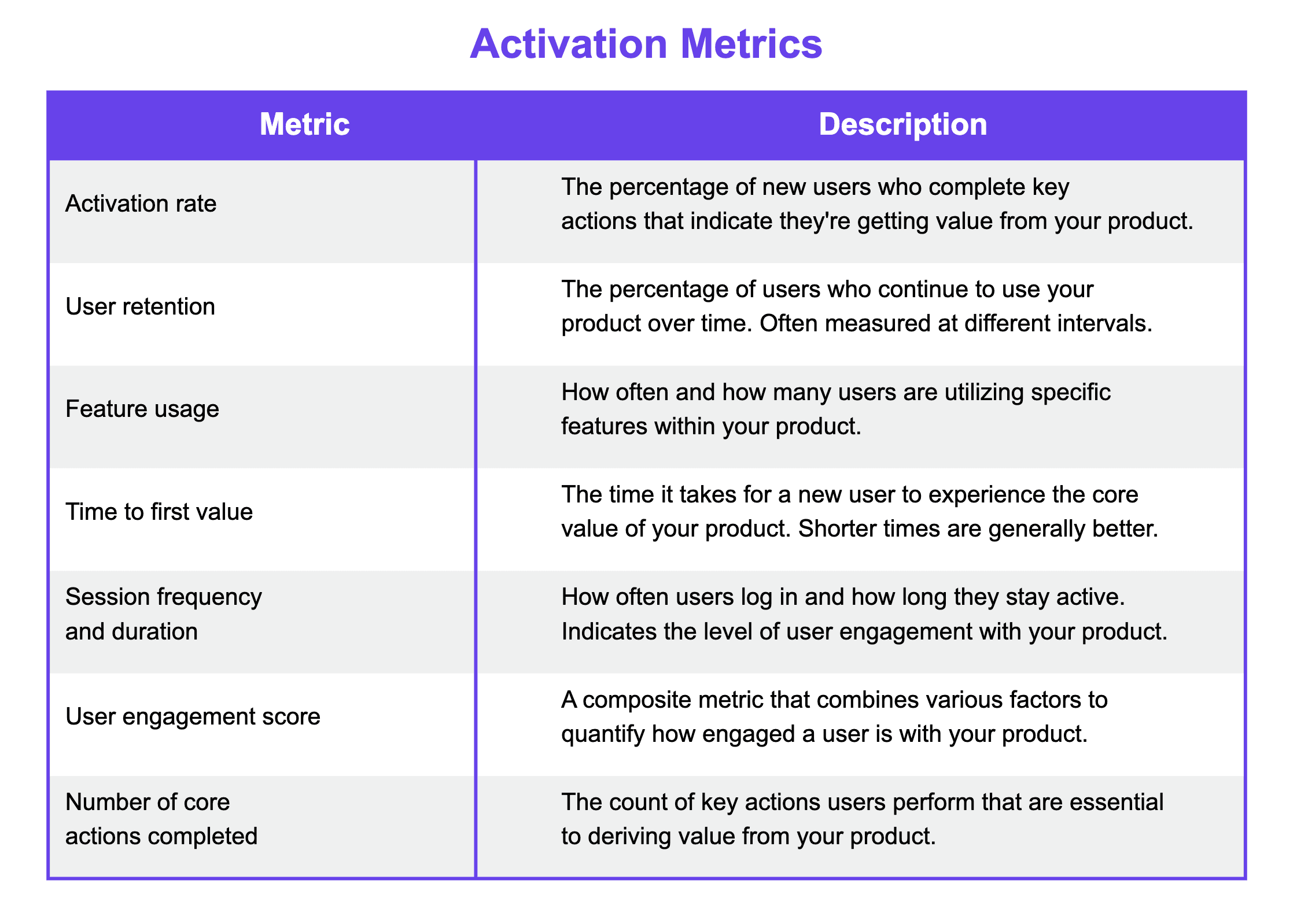
These metrics help you identify areas of your product that might need improvement or features that are particularly popular with users. For instance, if you notice that users who use a certain feature are more likely to stick around, you might want to highlight that feature more prominently in your onboarding process.
Activation is crucial because it's where users start to experience the value of your product. The quicker and more effectively you can demonstrate this value, the more likely users are to become long-term customers.
Conversion
Ultimately, the goal is to convert users into paying customers. Here, we're looking at:
Conversion rates
Customer churn
Revenue-related metrics (MRR, ARR, LTV)
Upgrade rates
Downgrade rates
Time to conversion
Average revenue per user (ARPU)
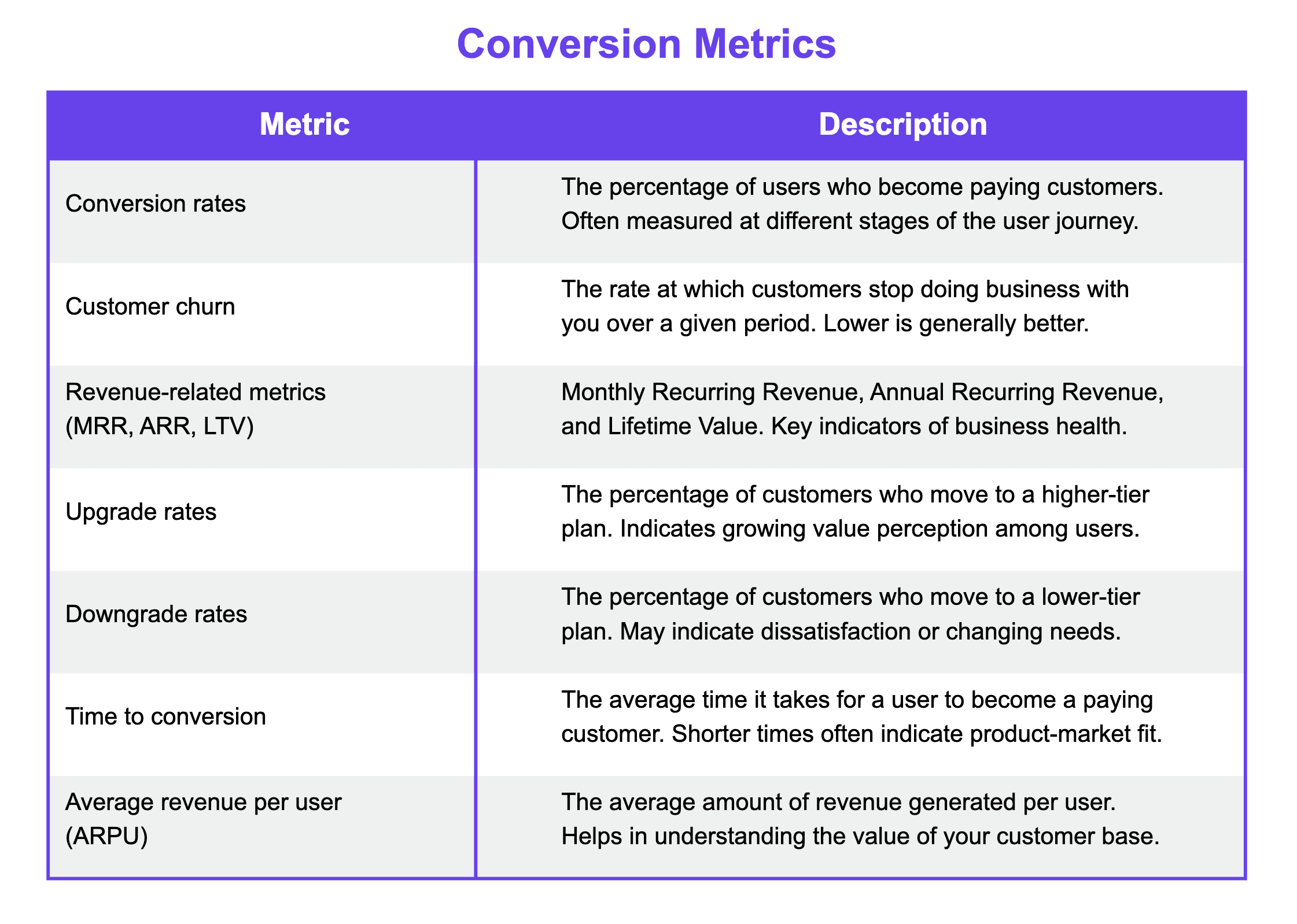
By tracking these, you can optimize your monetization strategies and improve your overall business performance. For example, if you notice that users tend to upgrade after using a particular feature, you might consider making that feature a premium offering.
Understanding your conversion metrics also helps you identify your most valuable user segments. This information can inform your product development roadmap, ensuring you're building features that appeal to your highest-value customers.
How is User Behavior Tracked?
Now that we understand what to track, let's look at how it's done. The technology behind user behavior tracking is relatively straightforward. For websites and web-based products, it typically involves a small piece of JavaScript code embedded in your site. This code records user actions and sends the data back to your tracking software.
Here's a bit more detail on how it works:
The tracking code is loaded when a user visits your site or opens your app.
As the user interacts with your product, the code records these interactions as events.
These events are sent to your tracking software, either in real-time or in batches.
The tracking software processes this data and presents it in a usable format (like charts or reports).
For mobile apps or desktop software, similar principles apply, but the specific technology may vary depending on the platform. iOS and Android apps, for instance, have their own SDKs for implementing tracking.
It's worth noting that the implementation of tracking should be done carefully to ensure it doesn't negatively impact your product's performance. Poorly implemented tracking can slow down your website or app, leading to a poor user experience.
Tools for Effective User Behavior Tracking
Let's move on to the tools you can use to implement user behavior tracking. There's a wide range of options available, each with its own strengths. Here are some popular choices:
Google Analytics: A free tool that provides a high-level view of website usage and basic conversion metrics. It's great for understanding traffic sources and user demographics. Google Analytics is often the starting point for many businesses due to its ease of use and comprehensive basic features.

2. Mixpanel or Amplitude: These offer deeper insights into user behavior, allowing for more granular tracking and analysis. They're particularly good for event-based tracking and cohort analysis. These tools are excellent for
understanding user journeys and identifying patterns in user behavior.
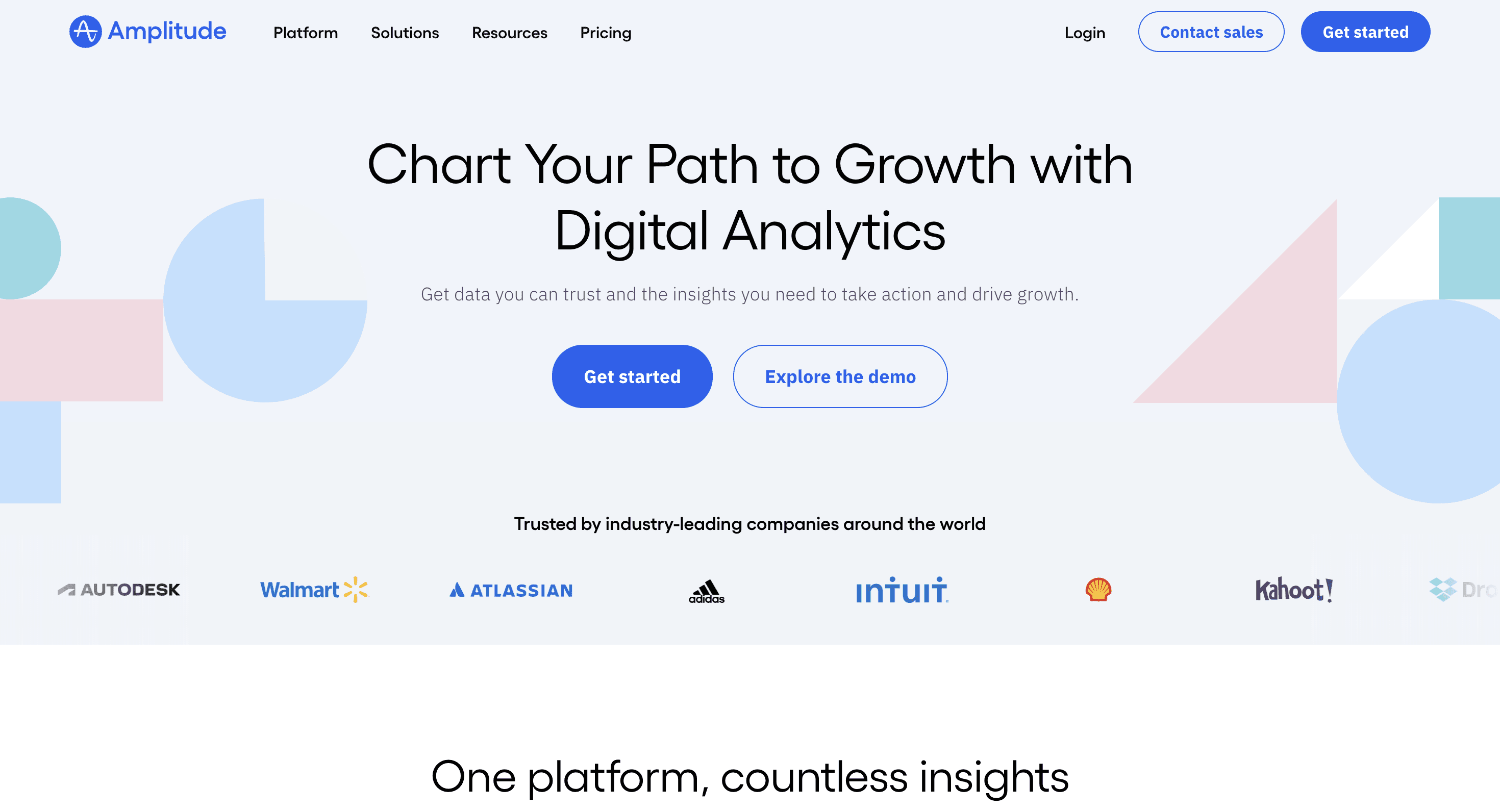
Hotjar: Great for UX research, offering features like session recording and heatmaps. It's invaluable for understanding how users actually interact with your interface. Hotjar can help you identify usability issues that might not be apparent from quantitative data alone.
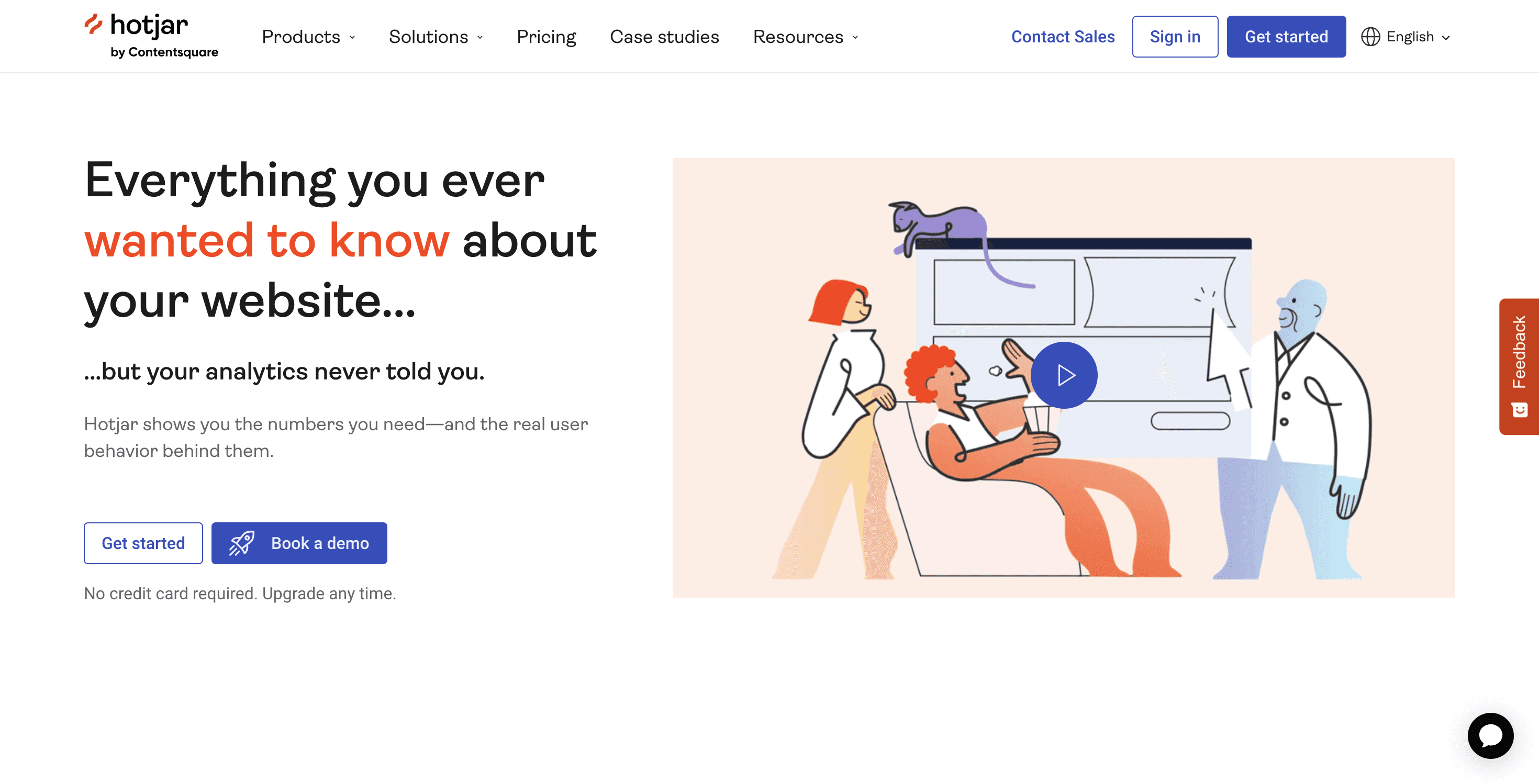
PostHog: An open-source platform that provides comprehensive tracking and analysis capabilities. It's a good choice if you want more control over your data and are comfortable with a more technical setup.
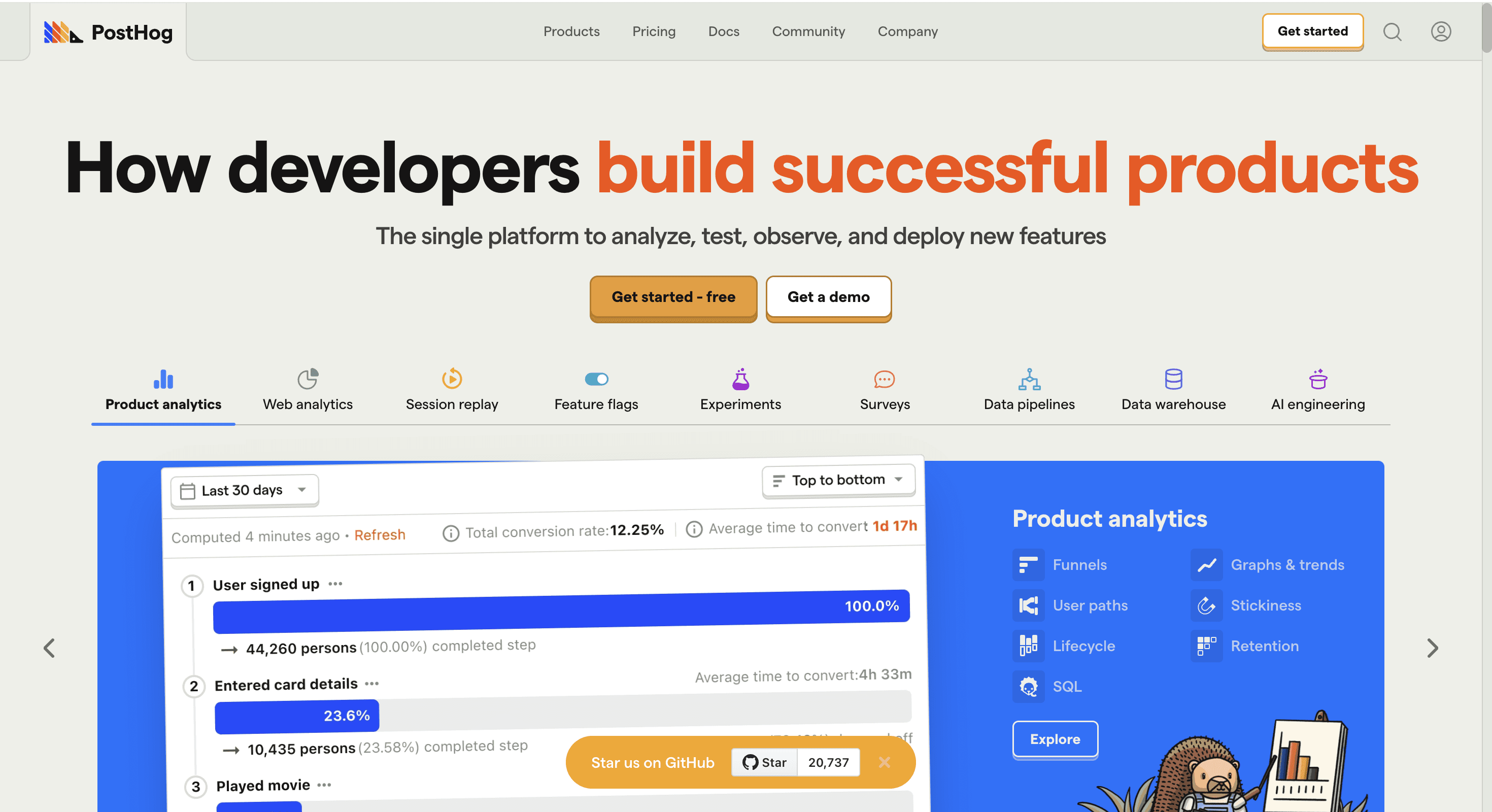
Hyperaktiv: A growth copilot designed specifically for SaaS companies, helping with user segmentation and targeted messaging. It's particularly useful for companies looking to implement personalized marketing strategies based on user behavior.
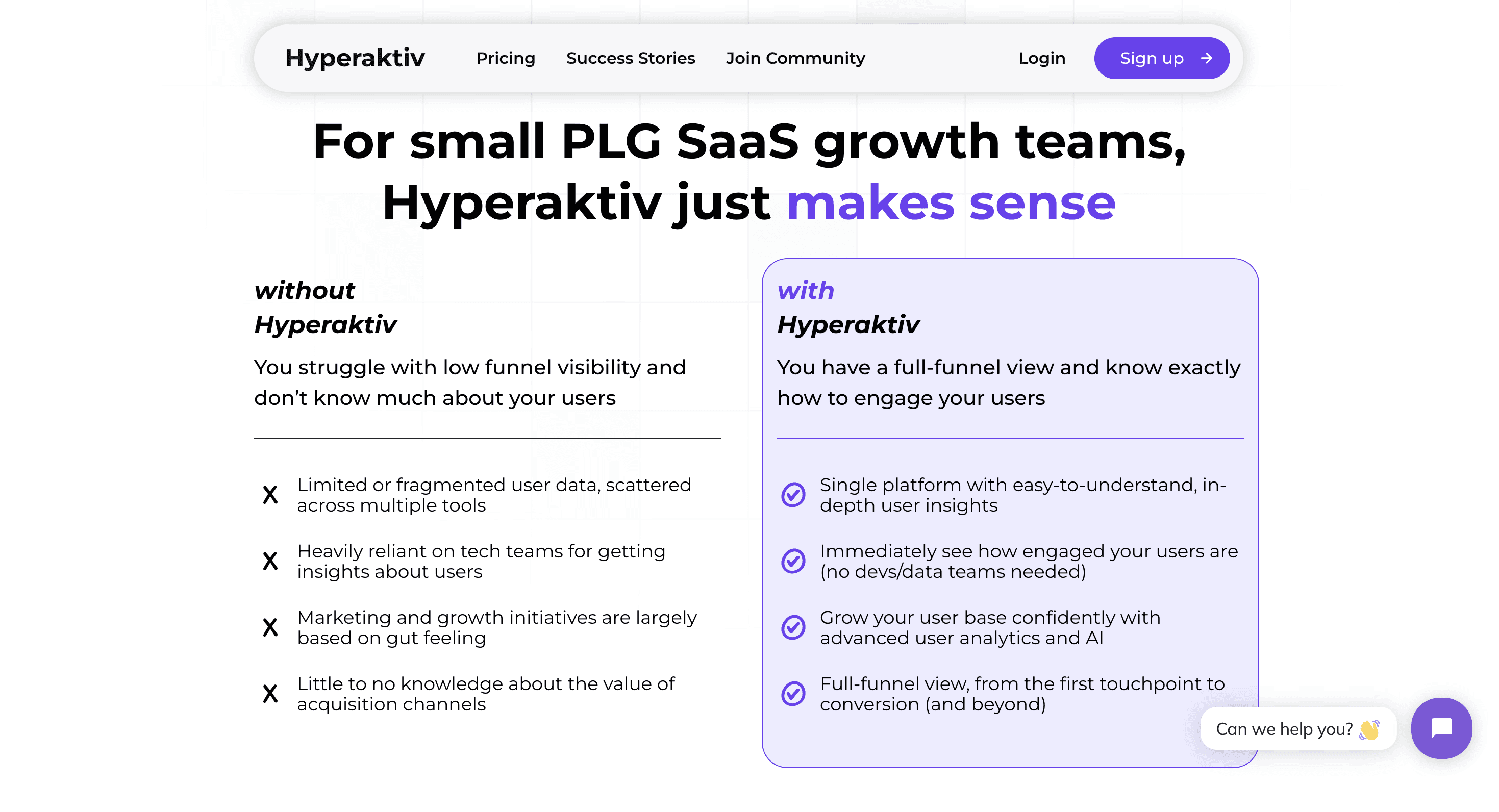
The choice of tool often depends on your specific needs and the role of the person using it. For instance, a marketer might prefer Google Analytics, while a UX designer might lean towards Hotjar. Many companies use a combination of tools to get a complete picture of user behavior.
When selecting your tools, consider factors like:
The specific metrics you need to track
Your budget
The technical expertise of your team
Integration capabilities with your existing tech stack
Data privacy and security features
Implementing User Behavior Tracking
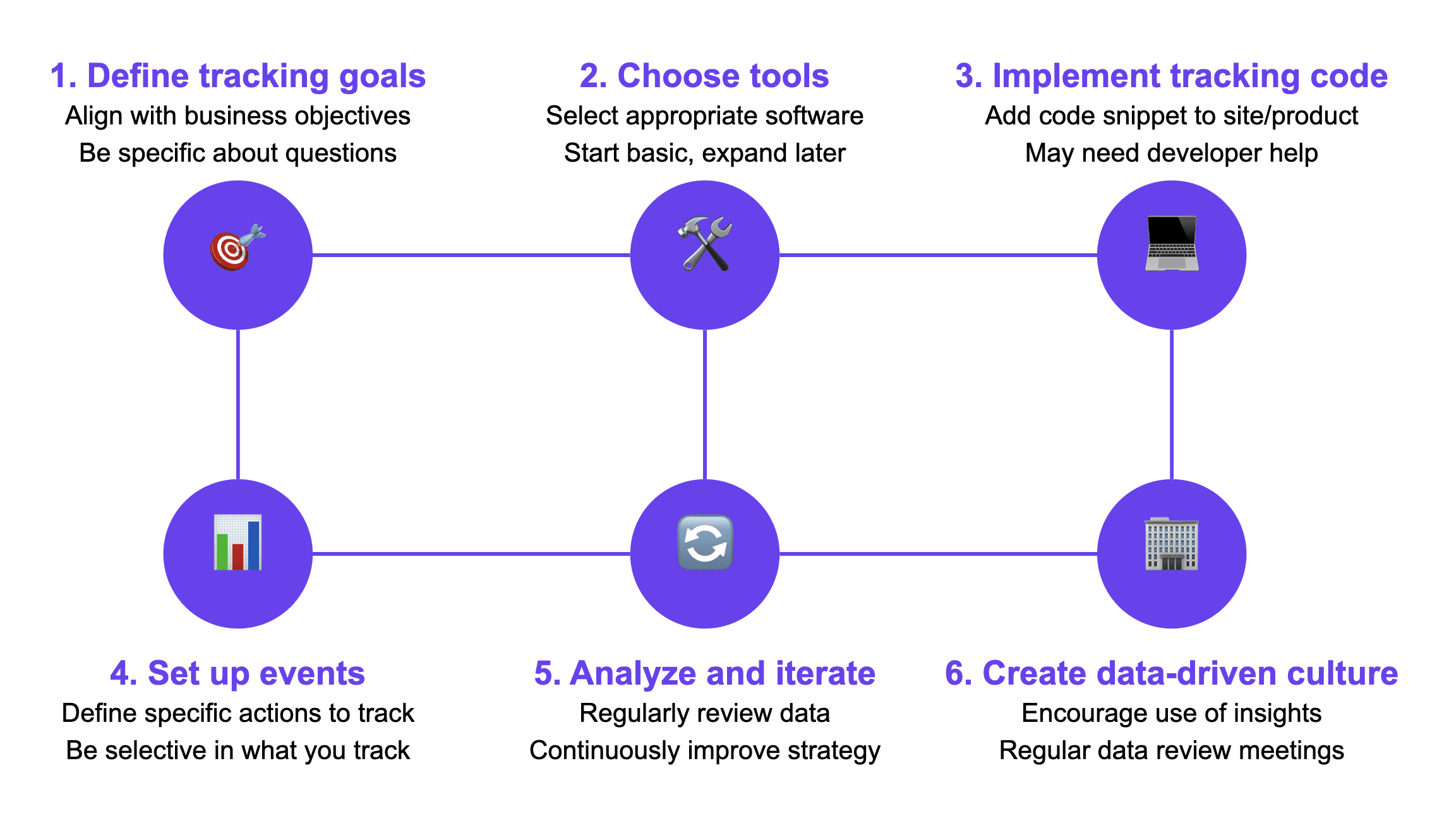
Now, you might be wondering, "This all sounds great, but how do I actually implement it?" Don't worry, it's not as daunting as it might seem. Here's a simple process to get you started:
Define your tracking goals: What do you want to learn about your users? This should align with your overall business objectives. Be specific about the questions you want to answer through user behavior tracking.
Choose your tools: Based on your goals, select the appropriate tracking software. Remember, you might need more than one tool to cover all your bases. Consider starting with a basic setup and expanding as you become more comfortable with tracking and analysis.
Implement the tracking code: This usually involves adding a snippet of code to your website or product. Many tools provide easy-to-follow instructions for this step. If you're not technically inclined, you might need help from a developer for this part.
Set up your events: Decide what specific actions you want to track. This might include things like button clicks, page views, or feature usage. Be thoughtful about what you track - not every action needs to be an event.
Analyze and iterate: Regularly review your data and make improvements based on your findings. This is an ongoing process - the digital landscape is always changing, and so should your tracking strategy.
Create a data-driven culture: Encourage your team to use the insights gained from user behavior tracking in their decision-making processes. This might involve regular data review meetings or incorporating data analysis into your product development workflow.
Remember, implementing user behavior tracking is not a one-time task. It requires ongoing attention and refinement to ensure you're always getting the most valuable insights.
Privacy Considerations
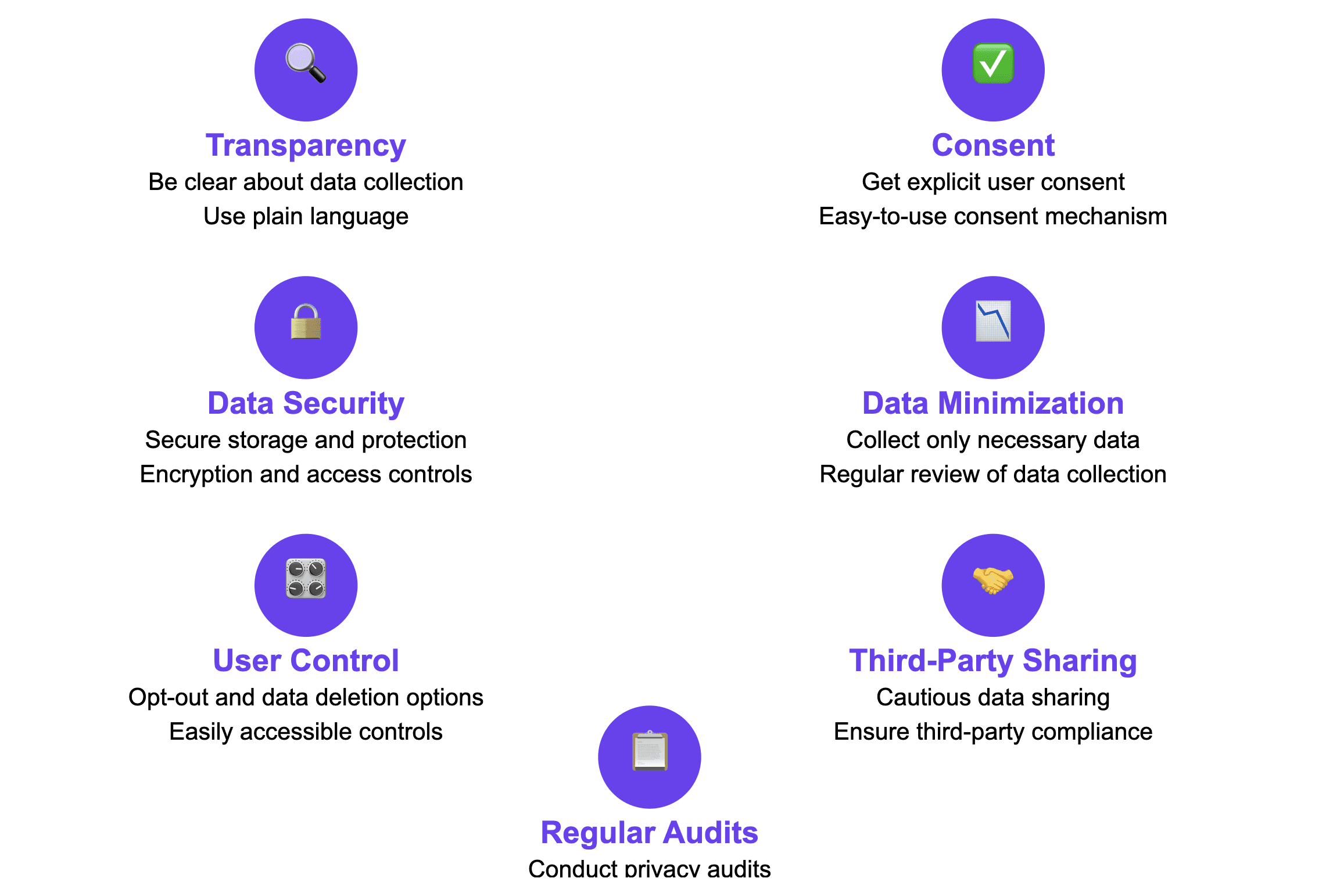
As we dive deeper into user behavior tracking, it's crucial to address the elephant in the room: privacy. With regulations like GDPR and CCPA in place, it's more important than ever to handle user data responsibly. Here are some key points to consider:
Transparency: Be clear about what data you're collecting and why. This information should be easily accessible in your privacy policy. Use plain language that your users can understand.
Consent: In many jurisdictions, you need explicit consent from users before tracking their behavior. Implement a clear and easy-to-use consent mechanism. This might involve a cookie banner or a privacy settings page.
Data Security: Ensure that the user data you collect is stored securely and protected from unauthorized access. This might involve encryption, access controls, and regular security audits.
Data Minimization: Only collect the data you actually need. More data isn't always better, especially when it comes to privacy concerns. Regularly review your tracking setup to ensure you're not collecting unnecessary information.
User Control: Provide users with options to control their data, including the ability to opt-out of tracking or delete their data. Make these options easily accessible and straightforward to use.
Third-Party Sharing: Be cautious about sharing user data with third parties. If you do need to share data, ensure you have the necessary permissions and that the third party adheres to strict privacy standards.
Regular Audits: Conduct regular privacy audits to ensure you're complying with all relevant regulations and best practices. This might involve working with legal experts or privacy consultants.
Remember, user behavior tracking is not a set-it-and-forget-it process. It requires ongoing attention and adaptation. But with the insights it provides, you'll be well-equipped to drive growth and success for your SaaS business.
By leveraging user behavior tracking effectively, you can create a data-driven strategy that propels your SaaS business forward. You'll be able to make informed decisions, improve your product based on real user needs, and ultimately deliver more value to your customers.
So why wait? Start tracking, start learning, and start growing! The data is out there - it's time to put it to work for your business. With a thoughtful approach to user behavior tracking, you can unlock insights that will drive your SaaS company to new heights of success.




